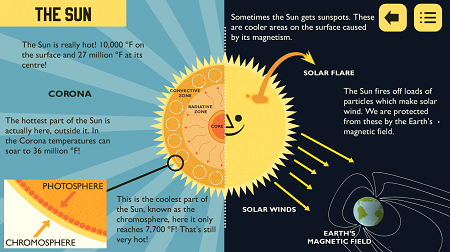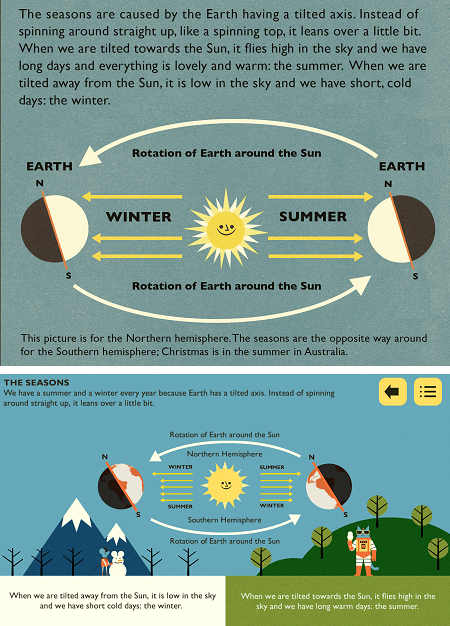Professor Astro Cat Goes Digital
By Dianne Timblin
It’s no secret we're serious fans of the dapper and witty Professor Astro Cat. The mobile app Professor Astro Cat’s Solar System (Minilab Studios, $2.99, iOS and Android) translates a portion of the material from the first book, Professor Astro Cat’s Frontiers of Space, for an interactive digital format. We decided to take it for a cosmic joyride.
September 9, 2016
Science Culture Art Astronomy Communications Review Scientists Nightstand

It’s no secret that we here at Science Culture Central are serious fans of the dapper and witty Professor Astro Cat. We included his first book (okay, technically the first of two penned by Dominic Walliman and illustrated by Ben Newman) in our 2014 science book gift guide, and we reviewed his second book in Scientists’ Nightstand back in the spring.
When it comes to works featuring professorial feline space cowboys, we’re completists, so we have one more item to share. The mobile app Professor Astro Cat’s Solar System (Minilab Studios, $2.99, iOS and Android) translates a portion of the material from the first book, Professor Astro Cat’s Frontiers of Space, for an interactive digital format.
Brimming with details about our particular corner of the universe, Professor Astro Cat’s Solar System aims for space enthusiasts aged 6–8 according to the app’s publisher. But since the material is closely adapted from Frontiers of Space, which is geared for kids 7–11, somewhat older children are likely to enjoy it as well.
The app's developers have done a great job of tailoring the series’ signature stylish, whimsical aesthetic to suit a digital format, rescaling the book’s large-format artwork for palm-sized devices while introducing some interactive elements. A colorful depiction of the Solar System anchors the player’s experience, serving as a starting point and home base. From there, the player can pan out to see the Milky Way or swipe horizontally to learn about the Sun, its planets, the Earth’s Moon, and space travel. As players dig in to investigate, a vertical swipe unzips each celestial body (as well as the lunar capsule, delightfully) to reveal its layers of composition and to present a compact array of fascinating facts.

Structurally, the app presents many possible paths players can take as they explore the Solar System, which adds to the unfettered fun. I enjoyed being able to amble around at will, without being marched through the information in a particular order. Our volunteer app tester (that would be my niece, who was 9 when she recently took the app for a spin—but she would want me to note that she has since turned 10), being achievement minded, zoomed immediately to her favorite planets, where she went right to the quizzes. Although the screen layout tacitly suggests reading and clicking through the information and diagrams before taking the quizzes (and the button for a quiz doesn’t become active until the player digs into at least one level of detail), the design of the app allows players to choose how they experience it.
So kids who might get frustrated by taking the quizzes too soon can see that they have lots of info to investigate before taking the “jet pack challenges” (as the quizzes are called). Meanwhile, those like my niece can jump right into the fray, and then investigate the details about questions they missed. And those who aren’t inclined to take the quizzes can just tap away and enjoy the tour. (Taking the quizzes does unlock a bit more fun, though. After each challenge, spiffy personalized certificates pop up and players receive puzzle pieces to assemble into a rocket. Following the final quiz, the rocket takes off, transporting the player's avatar and Astro Cat through the Solar System.)

Since the app’s content is mostly drawn from Professor Astro Cat’s Frontiers of Space, a question naturally arises: Book or app? Both choices are rock solid, so the answer would depend on the nature and preferences of the reader.
The book makes full use of its large-format pages, conveying a great deal of information by tucking text into any available nook—appearing basically wherever the words won’t interfere with the illustrations. It also has a broader focus: the Solar System comprises just one part of the book, which goes on to discuss topics such as jet propulsion, the speed of light, and the future of space travel. Since the book covers more content overall, is a bit denser page by page, and maximizes the impact of its illustrations, which are bold and wonderfully numerous, it should be a hit with avid readers who love getting lost in a book, whether on their own or alongside a readerly adult.
The app’s somewhat more saturated color palette suits the interactivity it encourages: It feels like a bright, exciting cosmic space to tap your way through. Players explore and investigate, pursuing whatever image or information strikes their fancy, in whatever order. Readers can always approach the book in an unstructured way if they choose to do so, but the app seems thoughtfully designed to combine unstructured, enlightening play (as players decide where to go next and how deeply to dig into a topic) with some structured, playful learning (especially through the jetpack challenges, which nest neatly within a small batch of screens that provide all the answers if the player digs deeply enough). Those who enjoy mixing reading with a bit of digital spelunking should have a great time with the app.

That said, it’s easy to imagine that readers and players would enjoy digging into both the book and the app, even though they’d encounter some repeated information. The app includes animations as well as jokey asides that don’t appear in the book—and in some places information has been broken up in fresh ways or has been refined and clarified. (See, for example, the comparison of how the book and app explain the Earth’s seasons, above.) Yet the book includes a breadth of astronomical topics and an array of fantastic illustrations that are hard to pass up. The depictions of the lunar lander and the 1969 Apollo Moon suit alone are worth the price of admission, or a trip to the library.
Whether you check out the app, the book, or both, you’re in for some great cosmic entertainment. And for those die-hard Astro Cat fans out there: Lest you start feeling concerned that, after lapping up both of the books as well as the app, you’ve reached the end of the journey, never fear. Professor Astro Cat’s Intergalactic Activity Book will arrive in the States in December.
American Scientist Comments and Discussion
To discuss our articles or comment on them, please share them and tag American Scientist on social media platforms. Here are links to our profiles on Twitter, Facebook, and LinkedIn.
If we re-share your post, we will moderate comments/discussion following our comments policy.